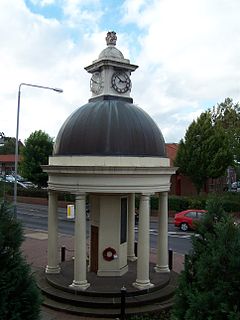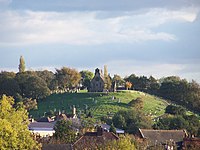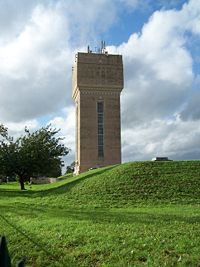Kimberley, Nottinghamshire
| Kimberley | |
|---|---|
| Town and civil parish | |
 Kimberley War Memorial | |
 Parish map | |
Location within Nottinghamshire | |
| Area | 1.11 sq mi (2.9 km2) |
| Population | 6,033 (2021) |
| • Density | 5,435/sq mi (2,098/km2) |
| OS grid reference | SK 49995 44702 |
| • London | 110 mi (180 km) SSE |
| District | |
| Shire county | |
| Region | |
| Country | England |
| Sovereign state | United Kingdom |
| Areas of the town | List
|
| Post town | NOTTINGHAM |
| Postcode district | NG16 |
| Dialling code | 0115 |
| Police | Nottinghamshire |
| Fire | Nottinghamshire |
| Ambulance | East Midlands |
| UK Parliament | |
| Website | www |
Kimberley is a market town and civil parish in the Borough of Broxtowe in Nottinghamshire, England, lying 6 miles northwest of Nottingham along the A610. The town grew as a centre for coal mining, brewing and hosiery manufacturing. At the 2011 census the town had a population of 6,053,[1] and this fell to 6,033 at the 2021 census.[2]
History
[edit]Kimberley is referred to as Chinemarelie in William the Conqueror's Domesday Book. With the accession of William to the throne Kimberley came into the possession of William de Peveril.[3] The Peverils lost control when they supported the losing side in the civil war which preceded the accession of Henry II of England in 1154. The King became the owner of the land. King John of England granted land in the area to Ralph de Greasley in 1212 who took up residence at Greasley Castle and also at around this time to Henry de Grey whose son re-built Codnor Castle on the site of an earlier castle established by William Peveril.[4]
Ralph de Greasley's land passed by inheritance and marriage to Nicholas de Cantelupe who took part in Edward III of England's Scottish campaigns and also the Battle of Crécy. Nicholas founded Beauvale Priory using part of his Kimberley holding in 1343. That part of Kimberley which had become the property of Beauvale Priory was claimed by King Henry VIII during the Dissolution of the Monasteries in the 16th century.[4]
The Priory's land was redistributed by the King and came into the possession of Arthur Capell, 1st Baron Capell of Hadham again by inheritance and marriage in 1627. Arthur was beheaded in 1649 having fought for the Royalists in the English Civil War. Arthur's son was created Earl of Essex in 1661.[4]
In 1753 the land was purchased by Sir Matthew Lamb whose grandson William Lamb became Prime Minister in 1834. The Lamb's Kimberley estates passed by marriage to the 5th Earl Cowper in 1805 and on the death of the 7th Earl in 1913 were sold off in pieces.[4]
That part of Kimberley retained by the Cantelupe's passed by inheritance and marriage to John Lord Zouch who died at the Battle of Bosworth with Richard III in 1485. He was posthumously found guilty of high treason with his property forfeited to Henry VII. John Savage (-1491) received this part of Kimberley in gratitude for his efforts on behalf of Henry VII at Bosworth. The Savage family sold this land to the Earl of Rutland in the early 17th century. The Duke of Rutland's Kimberley estates were sold in parcels in the early 19th century.[4]
Industry
[edit]Kimberley has been home to a lot of industry including: coal mining, brewing and hosiery manufacturing.
All major industry in Kimberley has stopped, the last being Kimberley Brewery which ceased brewing in December 2006. Most businesses are now retail-based concerns.
Kimberley today
[edit]One of Kimberley's most notable structures is its unusual war memorial, in the form of a rotunda which is used as the emblem of Kimberley School. This secondary school has a catchment area which extends into the neighbouring areas of Nuthall, Eastwood, Watnall, and Hempshill Vale.

On the south side of Kimberley lies Swingate, which has many different walking and cycling routes into the woods and surrounding countryside.
The twin towns of Kimberley are Échirolles in France and Grugliasco in Italy.[5]
Kimberley Brewery was taken over by Greene King in 2006, another major brewer in a multimillion-pound deal which marked the end of the traditional Kimberley Ales as ale brewing ceased shortly afterwards and only a distribution centre remained there.
The former Kimberley Brewery site has within its boundaries a geological Site of Special Scientific Interest (SSSI). It is listed under the title of "Kimberley Railway Cutting"[6] as an important location for Permian Gymnosperm fossils. The Permian - Carboniferous unconformity can be found in the Kimberley Railway Cutting.
Since 1974, Kimberley forms part of the borough of Broxtowe. From 1894 to 1974 it was part of Basford Rural District Council area.
There has been speculation that the Nottingham Express Transit (NET) want to extend their tram line that currently terminates at Phoenix Park stop through Kimberley towards Giltbrook Retail Park.[7]
Famous residents
[edit]- William Bryan (1856–1933), first-class cricketer
- John Reynolds was British Superbike Champion, 1992, 2001 and 2004[8]
- Sergeant Richard Bolitho was the Rear Gunner on a Lancaster bomber which crashed with the loss of the whole crew during the Dambuster raid in World War II.[9]
Sport
[edit]
- Kimberley Town F.C. were the main local football team until they folded in 2012.
- Kimberley Miners Welfare F.C.
- Kimberley Institute Cricket Club is the town's cricket team.
- Awsworth - Kimberley & District Rifle Club
- Kimberley & District Striders Running Club
Media
[edit]Local news and television programmes are BBC East Midlands and ITV Central. Television signals are received from the Waltham TV transmitter,[10] and the Nottingham relay transmitter. [11]
Local radio stations are BBC Radio Nottingham, Capital East Midlands, Smooth East Midlands, Hits Radio East Midlands and Greatest Hits Radio Midlands. [12]
The town is served by local newspaper, Mansfield and Ashfield Chad (formerly Eastwood & Kimberley Advertiser). [13]
See also
[edit]- Listed buildings in Kimberley, Nottinghamshire
- Murder of Barbara Mayo, infamous unsolved killing of a woman who was apparently abducted from Kimberley in 1970
- Kimberley West railway station
- Kimberley East railway station
- Watnall railway station
- Kimberley Brewery
References
[edit]- ^ "Broxtowe ward population 2011". Neighbourhood Statistics. Office for National Statistics. Retrieved 11 April 2016.
- ^ UK Census (2021). "2021 Census Area Profile – Kimberley (Broxtowe) parish (E04007860)". Nomis. Office for National Statistics. Retrieved 25 January 2024.
- ^ Domesday Book: A Complete Transliteration. London: Penguin, 2003. ISBN 0-14-143994-7 p.772
- ^ a b c d e Lee, J.M. A Brief History of Kimberley.
- ^ "Twin Towns". Archived from the original on 24 June 2007.
- ^ "Kimberley Railway Cutting".
- ^ "Tram Extension: Supporters of Line to Kimberley Walk Route | East Midlands News". Archived from the original on 4 March 2016. Retrieved 12 January 2015.
- ^ "John Reynolds".
- ^ "Richard Bolitho". Archived from the original on 10 April 2009. Retrieved 13 July 2009.
- ^ "Full Freeview on the Waltham (Leicestershire, England) transmitter". UK Free TV. 1 May 2004. Retrieved 12 December 2023.
- ^ "Nottingham (Nottinghamshire, England) Full Freeview transmitter". UK Free TV. 1 May 2004. Retrieved 12 December 2023.
- ^ "Local news and radio". Nottinghamshire County Council. Retrieved 12 December 2023.
- ^ "Eastwood & Kimberley Advertiser". British Papers. 11 December 2013. Retrieved 12 December 2023.
Further reading
[edit]- Domesday Book: A Complete Transliteration. London: Penguin. 2003. ISBN 0-14-143994-7.
- Ottewell, David (2001). Old Kimberley. Stenlake Publishing. ISBN 1-84033-155-0.
- Lee, John.M. (2001). A Brief History of Kimberley (First ed.).
- Plumb, Arthur (1993). Kimberley in old picture postcards. European Library. ISBN 90-288-4669-7.
External links
[edit]- "Kimberley Railway Cutting".
- "Kimberley Railway Cutting photos".
- "Kimberley Town Council".
- YouTube video - parish visit journal

